
Tell us what you need to find a matching loft conversion specialist

Get free quotes from professionals near you

Compare offers and choose the one that best matches your need
- Householdquotes.co.uk
- Home Insulation
- Wall Insulation
- Wall Insulation Costs
How Much Does Wall Insulation Cost?

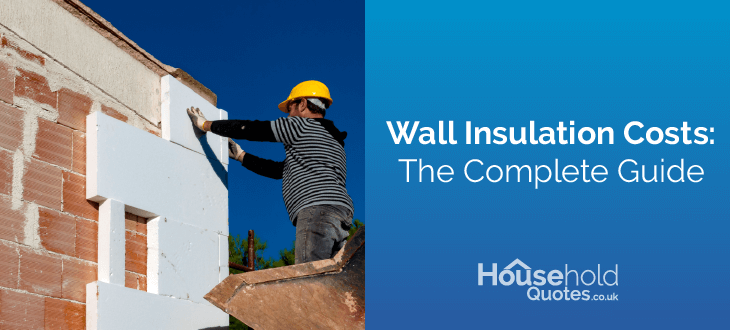
- Uninsulated walls account for up to 33% of heat loss experienced in your home.
- Cavity wall insulation in a standard detached UK home costs around £4,600.
- Complete wall insulation can save up to £406 - £550 on annual energy bills.
Uninsulated walls are one of the most sinister culprits in homes suffering from soaring energy bills. Responsible for up to a third of your home's heat loss, poorly insulated walls translate to wasted energy, higher bills, and a very uncomfortable living environment.
Fortunately, wall insulation offers a powerful solution that can significantly reduce this heat loss, leading to a warmer home, lower carbon footprint, and substantial financial savings of up to £550 per year in a standard detached house.
By the end of this ultimate guide, you’ll know exactly why wall insulation is one of the most effective home upgrades anyone could invest in. Read on to learn all about a typical house insulation cost, material prices, savings, and government grants that can reduce your costs.
Eager to upgrade your home? Look no further than Household Quotes UK for the best local installers at the best prices! Instead of spending countless hours aimlessly surfing the web and scheduling phone calls, just spend 30 seconds filling out our simple form, and receive up to 3 free home-tailored quotes. No hidden charges, no obligations. Click below to begin!
- Describe your needs
- Get free quotes
- Choose the best offer
It only takes 30 seconds



Average wall insulation prices
Average wall insulation prices for a standard semi-detached UK home sit at around £2,700 for cavity wall insulation, and £7,500 - £13,000 for solid wall insulation, depending on whether it's an internal or external wall job. These prices are lower if you live in a flat, and can be higher with detached houses and bungalows.
Wall insulation is a smart investment, but costs can vary depending on your specific situation, preferences and other factors. Here are some of the main things to consider:
- Your walls: Solid walls require more complex and expensive insulation compared to cavity walls with a pre-existing gap in place.
- Your home size: Naturally, a larger house with more wall area will cost more to insulate than a smaller property or flat.
- Chosen insulation material: Different materials offer varying levels of efficiency and costs. Consider factors like budget and desired performance when making your choice.
- Installation complexity: Existing conditions of your home, the need to remove old insulation, outstanding repairs, or even just make space for the job can play a role in your final costs.
- Installer costs: Labour costs can vary significantly depending on your location. Urban areas typically have higher labour rates than rural locations.
The UK government also offers grant schemes that may significantly reduce your insulation costs. We'll explore these grants in detail later in the article.
Cavity wall insulation cost
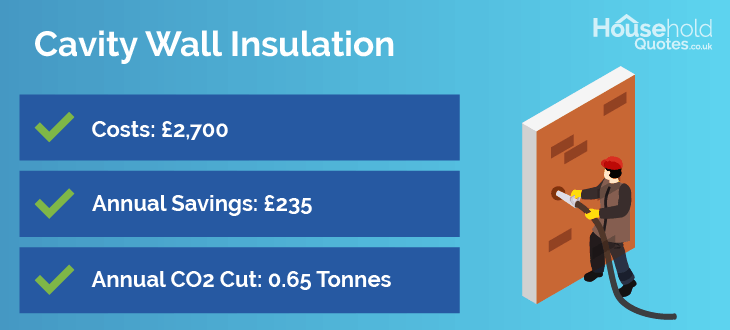
Wondering how much is cavity wall insulation? For a typical 3-bedroom semi-detached house in the UK, the average cost of cavity wall insulation is around £2,700. It's important to remember this is just a market average, and the factors discussed earlier can play a big role in quote price changes.
Many UK homes, particularly those built after the 1920s, feature cavity walls. These walls consist of two separate layers – typically a brick outer wall and a concrete inner wall – with an air gap in between. This cavity provides an ideal space for insulation material, significantly improving your home's thermal efficiency.
Here’s a breakdown of general costs for cavity fill insulation per home type, as well as how much you could expect to save annually on your energy bills:
| Type of home | Insulation cost (Cavity wall) | Annual energy savings |
|---|---|---|
| Flat / Apartment | £1,000 | £110 |
| Semi-detached home | £2,700 | £235 |
| Detached home | £4,600 | £406 |
| Mid terrace home | £1,500 | £140 |
| Detached bungalow | £2,100 | £175 |
Solid wall insulation cost
Solid wall insulation can range from £7,500 to £13,000, depending on whether you choose internal or external installation. Internal insulation measures generally tend to be cheaper, but both options are greatly influenced by factors like home size, wall conditions, and installation complexity.
Built before the 1920s, solid walls are indeed charming for homes and properties, but often lack the benefit of modern insulation measures, leading to drafty winters and high energy bills. Solid walls also lack a cavity space, which means that insulation material can only be secured internally or externally. This in turn makes it a more expensive process than cavity walls.
While solid wall insulation carries a significant upfront cost, the long-term benefits are undeniable:
- Big savings: Expect as much as £380 per year for a semi-detached home, putting money back in your pocket.
- Reduced CO2: Up to 0.9 tonnes of annual cuts to your domestic emissions in a semi-detached home, making a positive environmental impact.
- Improved comfort: A warmer and more temperature-regulated home year-round increases comfort in your living space.
Remember, a professional assessment is key. A qualified installer can provide a tailored quote considering your specific property and needs, helping you make an informed decision for a warmer, more energy-efficient home.
External wall insulation cost
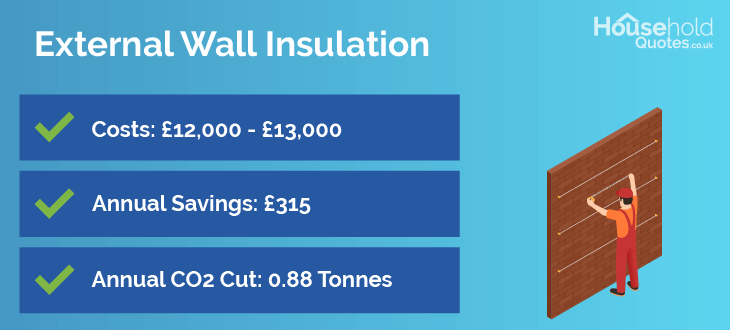
The average cost of external wall insulation tends to be on the higher end of the spectrum, costing around £12,000 - £13,000 for a full job, based on estimates from the Energy Saving Trust and the Royal Institution of Chartered Surveyors (RICS).
The process involves securing insulation material directly onto the outside walls of your property. Normally, rigid insulation boards are used given that they are waterproof, robust, and most likely to withstand weathering. The insulation is then covered with render and cladding to prevent moisture and weather damage.
Consulting with a qualified installer is crucial for a precise estimate tailored to your specific property. They can assess your home's size, features, and wall health to suggest the best insulation approaches for your needs.
Internal wall insulation cost

Internal wall insulation is generally a more budget-friendly option, typically costing around £7,500 for a complete project in a typical semi-detached UK home (according to RICS and Energy Saving Trust estimates).
There are two main methods for internal wall insulation, each with its price range:
- Dry lining: Involves directly attaching rigid insulation boards to your existing walls. These are then covered with plasterboard for a clean finish. Dry lining is generally the cheapest way to insulate internal walls, especially if you don't already have stud walls.
- Stud walls: A timber or metal frame is built out from your existing wall, creating a cavity. This cavity is then filled with insulation materials like mineral wool, fibreglass rolls, or even sheep wool. Finally, the plasterboard is fixed to the frame to form a new stud wall.
Keep in mind that the cost of internal wall insulation most often accounts for a full insulation job. This involves labour and equipment costs, prep work for your home, and other small jobs. However, there are several ways to make sure you save more money:
- Combine with other projects: If you're already planning renovations, repairs, or decoration, consider tackling your internal wall insulation at the same time. This way, you can leverage existing scaffolding and a cleared-out space, potentially reducing your overall costs, time and need for labour.
- Go room by room: There's no need to insulate your entire house at once if you can’t. Focus on one room at a time, especially for larger projects. This approach makes the cost more manageable and allows you to prioritise rooms that need it the most.
Are you eligible for insulation grants?
The UK government is offering insulation grants to help improve home energy efficiencies and domestic carbon footprints across the UK. These grants are part of the country's goal to achieve net zero emissions by 2050 and are designed to assist fuel-poor and energy-inefficient households.
There are two key grant programs currently open, both of which are active until March 2026:
- The Great British Insulation Scheme: This program focuses on ‘one-off’ insulation measures like cavity walls or solid wall insulation. It prioritizes reaching a wider range of homes and determines the most effective upgrade through a home assessment. You can apply directly through the government portal.
- ECO4 (Energy Company Obligation): This program requires energy companies to directly assist qualifying households. It offers a much wider range of upgrades compared to the Great British Insulation Scheme, including internal and external wall insulation. To apply and see if you qualify, contact your energy provider directly.
- Low-income households: Grants typically prioritize low-income households to help reduce energy bills.
- Energy Performance Certificate (EPC) rating: Homes with an EPC rating below D are strong candidates, as they are considered less energy-efficient.
- Government benefits: Receiving certain government benefits can also make you eligible for insulation assistance.
For a full understanding of the requirements you must meet to qualify for a wall insulation grant, consult the official UK government website.
Are there cheaper ways to insulate walls?
There are a few ways to make your wall insulation project cheaper, the best being to make use of any grant schemes you may be eligible for. With a grant scheme, you could significantly reduce or potentially get full coverage for wall insulation.
Not all is lost for those who don’t qualify for a grant. If you’re handy with tools and have researched, you can consider a DIY installation instead. Mind you, this is only relevant for internal wall insulation but can be up to three times cheaper than hiring a professional.
While the savings of DIY insulation can be tempting, it's crucial to weigh the potential downsides you could face:
- Disruption and time: Installing wall insulation, particularly internal walls, can be a very messy and lengthy process. This can disrupt your daily routine for weeks if you’re planning to go ahead with DIY.
- Faulty installation: Improper insulation can lead to problems like moisture buildup, mould growth, and even structural damage. Fixing these issues can be far more expensive than getting a professional installation in the first place.
- Safety concerns: Some insulation materials can be toxic, irritating to touch, or even harmful if inhaled. Proper safety gear adds to the cost of a DIY job, and improper handling can pose serious risks to your health.
When doing a proper risk assessment, a professional installation doesn’t seem all that bad, and can often wrap up to be your most affordable option in the long run! This is because you pay for a proper job that will last you for decades to come.
Here’s how you can land the best deal on professional installers:
- Compare quotes: Don't just compare prices – compare the details included in each quote price, like materials, removal of existing insulation, and any unforeseen prep work.
- Do your research: Ask about installer qualifications, accreditations, and insurance coverage. That way you can know if your money is going to a reputable company.
- Read reviews: Check review sites like Trustpilot to gain better insights into installer professionalism and client satisfaction.
DIY wall insulation
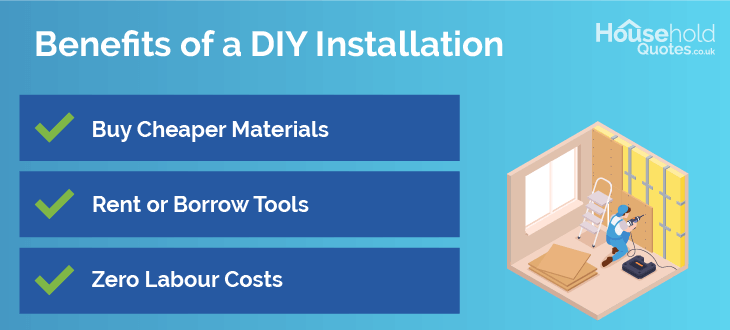
Leave cavity wall and external wall insulation to the professionals. These projects require the use of specialized equipment and expertise to tackle a very complex job. Internal walls, however, are a different story.
Internal wall insulation offers a more DIY-friendly approach to boosting your home's insulation for a fraction of the cost of a professional installer.
- Cost savings: A professional installation can add up quickly, with labour costs often accounting for up to 60% of the total price you pay. By doing it yourself, you eliminate those high labour fees.
- Material choice: You have complete control over the insulation materials you use. While this doesn’t guarantee finding the cheapest option, it allows you to pick what best fits your budget and priorities.
- Tools: Professional installers come equipped with all the necessary tools as part of their quoted price. By tackling the project yourself, you can rent tools for a fraction of the cost, or even borrow them from friends or neighbours.
The approach for internal wall insulation you take will depend on the existing walls in your home. Based on this, you can decide whether to go ahead with dry lining or stud wall insulation:
- Existing stud walls: You're in luck! Adding insulation between the studs is a relatively straightforward and time-effective process for an experienced DIYer.
- New stud walls: Building entirely new stud walls is a complex job alongside an already complex insulation. For this task, it's best to call in a professional. A more time-effective approach would be to do dry-lining insulation directly on your existing walls.
In any case, it’s strongly advised to work with a professional insulation company, as there will be plenty of bumps in the road and home specifics to consider. Some of these include relocating electrical wires, properly securing insulation, adding a vapour barrier and many more.
What are the pros and cons of cheaper insulation materials?
Insulating your home can be a hefty investment, but that doesn't mean you have to break the bank. A variety of insulation materials exist, catering to different budgets and needs. Some offer great cost-saving options while still providing impressive heat retention capabilities.
Generally, expensive insulation offers better heat retention. This translates to better energy efficiency, lower energy bills and a more comfortable living space. However, a downside is that these high-performance materials aren't always environmentally friendly, easy to produce, or available in the market.
Take Polyurethan boards for example. While a champion in effectiveness, they can release harmful fumes and toxic chemicals through off-gassing. This makes it a potentially hazardous choice, despite its impressive insulating power above most other materials.
So, how do you find the perfect balance between affordability and performance? For starters, let's take a look at insulation materials used in internal and external wall jobs, and their costs:
| Insulation material | Purpose | Average price (per m2) |
|---|---|---|
| PIR boards | Internal / External | £5 – £15 |
| Fibreglass | Internal | £10 |
| (EPS) Polystyrene boards | Internal / External | £10 |
| Cellulose | Internal | £10 - £12 |
| Mineral (Glass) Wool | Internal | £13 - £17.5 |
| Cork boards | Internal / External | £17 - £22 |
| Sheep wool | Internal | £17.5 - £22 |
| Mineral (Rock) Wool | Internal | £18.2 |
| Polyurethane boards | Internal / External | £21.5 |
For cavity wall insulation, a different set of materials are used. These are normally blown insulation, polystyrene beads, and polyurethane foam. Let’s have a look at their costs:
| Insulation material | Purpose | Average price (per m2) |
|---|---|---|
| Blown insulation (Mineral wool) | Cavity walls | £13 - £18 |
| Polystyrene beads | Cavity walls | £18 - £22 |
| Polyurethane foam | Cavity walls | £22 - £26 |
Here's where the good news comes in! Several affordable insulation materials still excel in both heat retention and market availability, making them great choices for your home:
- Mineral wool, cellulose, and sheep wool: These internal wall insulators provide effective heat retention at a reasonable price. They also don’t off-gas harmful chemicals and volatile organic compounds (VOCs) that are commonly found in synthetic options like Polyurethane foam.
- PIR boards: These rigid boards offer excellent thermal resistance for their price, and are very easy to handle, especially in DIY insulation jobs. An even more sustainable alternative is cork boards, providing high heat retention and no off-gassing risks.
- Blown insulation (cavity walls): For cavity walls, blown-in mineral wool insulation reigns supreme. This eco-friendly and cost-effective method performs just as well as synthetic insulations, with no risks of releasing toxins during and after installation.
Is wall insulation worth it?
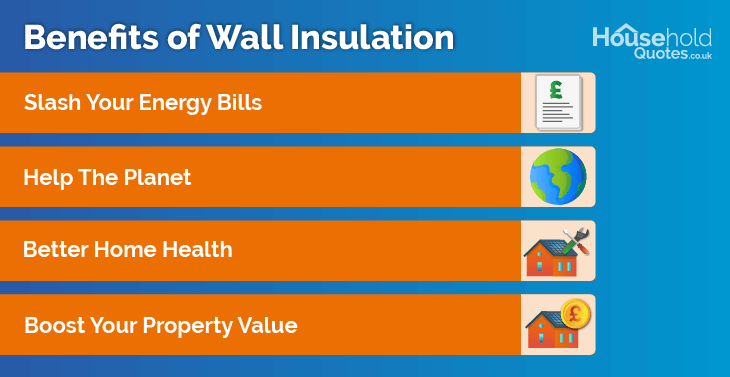
From keeping your wallet full to creating a healthier and more comfortable home, wall insulation is a worthwhile upgrade that will pay off in benefits for decades ahead. Here are just some of the main advantages that make wall insulation worth it:
- Slash your energy bills: Wall insulation can reduce heat loss by up to a third, meaning your heating system doesn't have to work as hard. In a semi-detached house, this translates to potential savings of £235 per year. That's money back in your pocket!
- Help the planet: Less heat loss leads to a smaller carbon footprint. By insulating your walls, you could be reducing your home's CO2 emissions by up to 0.9 tonnes annually; a significant contribution to a greener future.
- Better home health: Poorly insulated walls lead to draft and dampness, which in turn aids mould growth. Mould damages your property and also triggers respiratory problems. Wall insulation helps eliminate dampness and foster a healthy living environment for you and your loved ones.
- Boost your property value: Homes with higher Energy Performance Certificate (EPC) ratings tend to sell or rent for more. Additionally, external wall insulation provides a protective layer to your outer brickwork, preserving its stability for decades to come.
Eager to start? Let Household Quotes UK set you on the right path. Instead of spending countless hours stuck on websites and phone calls for research and vetting, we can provide you with industry-competitive quote prices tailored to your home specifics from our network of trusted installers.
Simply fill in our 30-second online form and receive up to 3 free quotes for wall insulation. No extra charges or obligations apply. Click below to begin!
- Describe your needs
- Get free quotes
- Choose the best offer
It only takes 30 seconds



FAQ
For a typical 3-bedroom semi-detached UK house, cavity wall insulation costs around £2,700, external wall insulation costs between £12,000 – £13,000, and internal wall insulation costs around £7,500. The cost of wall insulation can vary depending on factors such as the type of insulation you choose, the size of your home, and installation complexity.
A cavity wall insulation cost typically sits around £2,700 for a semi-detached UK house. Your property size and type, material selection, location and wall conditions will all play a role in your final investment. For a more accurate idea of cavity wall insulation costs for your specific property, consider using an online cavity wall insulation cost calculator. These tools usually require you to input details like your home’s dimensions and location.
An external wall insulation cost generally ranges around £12,000 – £13,000 for a semi-detached UK property. To get a more accurate idea of the cost for your specific property, it’s recommended to get quotes from several professional installers. They can assess your property and provide a tailored estimate suited to your property.
Several factors come into play, but generally, insulation grants target households with lower incomes, homes with EPC ratings of D or below, or those receiving specific government benefits. To get the most accurate details on eligibility and available grants, check the official UK government portal.

Akif has a keen interest in green home improvement solutions and the role of digital media in identifying climate trends. He aims to provide a multidisciplinary approach to content rooted in credible research and accuracy.
